#Star Wars music
Explore tagged Tumblr posts
Text
“The Yautja culture will make their first galactic EMPIRE”
#yautja#predator#predators#avp#the predator#i’ve been sleeping on yautja for tooooooo long#video editing#fugitive predator#wolf#predator berserker#Star Wars#star wars music#yautja x starwars#I want a star wars crossover with Predator now.#I just wanna see a combistick turned into a lightsaber.#and make them fight with the pretty light swords and sound effects
27 notes
·
View notes
Text
The Foreshadowing Hidden in Across the Stars
I'm sure people have noticed this before, but this is something that has given me chills ever since I was a little kid.
If you didn't know, Across the Stars is the love theme John Williams wrote for Anakin and Padmé. But there is one single version of Across the Stars that plays in the 10 minute long end-credit song of Attack of the Clones. If you don't watch all the credits (or listen to soundtrack scores like me), you will never hear it. And yet, John Williams decided to add in this terribly, horrifically beautiful bit of foreshadowing to the fucking song.
I urge you to listen to the entire 10 minute song to feel the buildup, but if you're impatient, just listen from the 9:00 mark to 10:30.
youtube
At the very end of the love song, in low tones beneath the melody, the Darth Vader/Imperial march song plays menacingly in the background.
And I think this is an absolute stroke of genius.
John Williams, at the end credits of Attack of the Clones, is basically telling you what happens in the next movie.
That love creates the monster.
That this love will be the catalyst, and darkness will follow.
There is no other version of Across the Stars that has this, because it is only meant to be heard right before Revenge of the Sith.
I don't think I've ever heard foreshadowing in music before, at least not quite like this, and it drives me absolutely insane that he did this. How is anyone allowed to be such a genius?
#John williams#across the stars#John Williams is a genius#George Lucas is a genius#star wars#attack of the clones#Star Wars soundtrack#Star Wars music#confrontation with dooku and finale#anidala#anakin skywalker#padmé amidala#Youtube
123 notes
·
View notes
Text

*Dying noises*
#star wars#padmé amidala#anakin skywalker#anidala#pro anidala#john williams#across the stars#star wars music#shakespearean themes#classical literature#romeo and juliet
54 notes
·
View notes
Text
Luke and Mara (Mara Jade's Theme), conducted by composer Arturo Díez Boscovich, performed live by The Malaga Philharmonic Orchestra at the MOSMA Festival in Spain in 2017. The new compositions were written and performed to accompany Timothy Zahn's classic novel, Heir to the Empire. Speaking about this beautiful piece, composer Boscovich said, "I have composed the love theme for Luke Skywalker, who falls in love in this book -- don't think that Luke is as innocent as the Virgin Mary! He is also passionate man, and inside this chaos there is a woman, who is related with the Empire, she was a student of the Emperor. The love theme... this is the love theme between them; it is actually the theme for her, her leitmotif. This girl came from the dark side and she hates Luke Skywalker -- you know, it's like the classic story between Catwoman and Batman, these femme fatales who want to destroy these men. In this situation, we have the same thing; it is passionate love but also it has some real dark moments."
#star wars#mara jade#mara jade skywalker#luke skywalker#arturo diez boscovich#john williams#star wars music#star wars eu#sw legends#star wars expanded universe#love theme#thrawn trilogy#heir to the empire#timothy zahn#Malaga Philharmonic Orchestra#mosma festival#soundtrack#star wars legends
149 notes
·
View notes
Text
Shatterpoint: A Mace Windu Musical Concept Chapter 1: Guide Us
A fun fact about me besides my love of Star Wars is that I love musicals. I have no musical talent whatsoever, but I still like the idea of writing musicals. And in the last few days I’ve had a rather silly idea of taking Revenge of the Sith and framing it as a musical, that idea eventually morphed into a musical set during the Clone Wars, but from the perspective of Mace Windu.
Mace is an often misunderstood character, especially from people who never read legends. And I thought this would be a fun idea for me to just have some fun with this. So, I got to writing an opening song for this, though as I said I’m not a songwriter by any means, but if anyone really wants me to continue let me know.
Link to song.
Chapter 2: A Leader
Chapter 3: A Daughter
Guide Us
[The musical begins, the sounds of blaster fire, vague battlefield orders heard, sounds of struggle as smoke fills the screen, intercut with lights of lightsabers and blasters. Three young padawans followed by clones enter. The padawans desperate and feeling overwhelmed sing].
Padawan #1 Come on my Jedi Can’t you see? We must hold the line For if we fall, the people die.
Padawan #2 There’s too many We’re surrounded
Padawan #3 There’s too many of them.
Padawan #1 Hold the line!
Padawan #2: We need another plan.
[Clones Fall and a Jedi does as well. A chorus begins to be heard humming. This chorus of Jedi will frequently return, they’ll act as a sort of Greek Chorus]
Jedi Chorus: So many fall So many die The young and brightest of our order In the name of peace and a republic That does not care.
Padawan #3
Retreat! We must retreat
Jedi Chorus: Untrained for war Untrained for this Meant for peace, but what is peace? Have we lost our way.
[A clone Commander appears, he runs to the eldest of the padawans.]
Clone Commander: The droids have broken our lines, Commander, what are your orders?
[The Padawan hesitates, and the clone grows more desperate.]
Clone Commander: What are your orders?!
[Suddenly a commanding voice sounds out.]
Mace Windu: Hold the line, Commander. Hold the line! (To the Padawans) Young ones, courage now—this is not the time to falter.
[The smoke clears slightly as Mace Windu strides into view, his purple lightsaber igniting with a resolute hum.]
Jedi Chorus: Master Windu, champion of the Jedi… Master Windu, where justice and courage lie… Master Windu, the shield against despair, Master Windu, a light in shadows’ lair.
Mace Windu:
Listen, young ones, the storm is here, But a Jedi stands, we do not fear. The galaxy turns in endless strife, Yet we are the shield, the blade of life.
Feel the Force, let it guide, Hold to the light, don’t run, don’t hide. Even in darkness, hope will rise, For the Jedi endure where chaos dies.
[The Padawans, emboldened by Mace’s presence, sing with renewed strength, echoing his confidence.]
Eldest Padawan: Come on, let’s do this!
Other Padawans: Master Windu, we follow— For the Republic, we fight, fight, fight!
Mace Windu (Inner Monologue): Meant to be a leader, meant to be a warrior, But they don’t see my doubts—my barrier. Could have ended this war before it began, Had my sword at the ready, but I had doubt… I’m just a man.
We must fight, change our role, But all of this war—it takes its toll. I see them fall, I see them die, My brothers, my sisters—hear their cry.
Jedi Chorus: Master Windu, guide us, lead us… Master Windu, hear us, teach us… Master Windu, show us what a Jedi can be, Master Windu, the strength of us is he.
[Mace Windu fights back, uses his lightsaber to lead and destroy battle droids as he gives orders the music grows quiet signifying that we are listening to his inner thoughts.]
Mace Windu: Jedi, follow my lead The republic will not fall, this is our creed Fight for the light, fight not for peace We fight for justice, this war will cease.
Padawans and Clones (chorus): Hold the line, hold the light, In the shadow of war, we fight, fight, fight! For justice, for hope, for the galaxy’s flame, We’ll endure, we’ll prevail, we’ll honor the name!
Master Windu, guide us, lead us… Master Windu, hear us, teach us… Master Windu, show us what a Jedi can be, Master Windu, the strength of us is he.
[The scene ends with Mace Windu standing strong, his purple lightsaber cutting through the haze, the battlefield momentarily stilled as the music fades into silence. The Jedi Chorus lingers as if carried on the wind.]
#Star Wars#star wars musical#Musicals#mace windu#jedi#Mace Windu Musical#Star Wars music#This is probably a dumb idea#Shatterpoint
70 notes
·
View notes
Text

56 notes
·
View notes
Text
Me, pretending be a normal, non-obsessive Star Wars fan: yes I liked the Ahsoka end credit sequence the Normal Amount
Also me, to anyone that will listen: note the use of the taiko drums to bring us back to Ahsoka's samurai/Japanese aesthetic as opposed to the Mandalorian's cowboy/Western aesthetic; the presence of non-Jedi force-users such as loth-wolves and purrgils suggesting Ahsoka's continued journey engaging with the Force beyond the Jedi-Sith binary; the weaving in of historical Star Wars soundtrack motifs such as Where the Sun Sails and the Moon Walks and Burying the Dead; and the exquisite timing & placement of actors' names within the sequence e.g. Natasha Liu Bordizzo when Sabine's theme from Rebels begins to play, David Tennant in the visually busiest and connected section of the star map indicating Huyang's long life and extensive connections, and Eman Esfandi at the visually most lonely part of the star map as the journey line heads into isolation. Also note the intensification of the taiko drums during Sabine's theme, an intriguing juxtaposition of the "Jedi" (/samurai) identity and "Mandalorian" (/cowboy) identity, linking both identities with Sabine, and linking Sabine and Ahsoka in the audience's mind. In this essay I will-

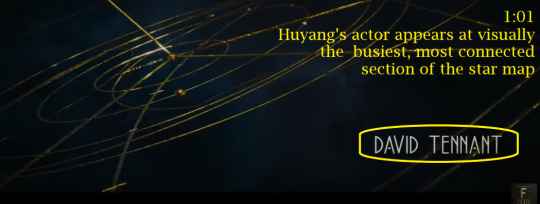
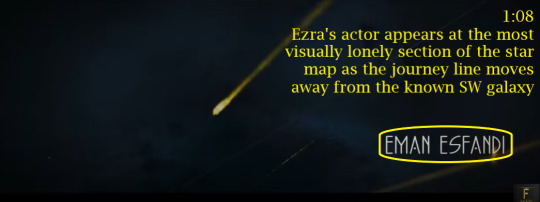

#literally started crying when I went back and watched Trials of the Darksaber to confirm Sabine's theme#have listened to this track on Spotify 6 million times#ahsoka#ahsoka tano#star wars rebels#star wars#star wars discussion#ahsoka end credits#star wars music#sabine wren#kevin kiner#ezra bridger
295 notes
·
View notes
Text

THE SONG PROGRESS BAR IS A LIGHTSABER?!
My life is a lie and I have been betrayed. Why did I not know this? Why did no one tell me? Consider this as me telling you. This is actually so sick. I think all Star Wars soundtrack music does it, and apparently you can change which saber it is somehow but I can't get it to work.
35 notes
·
View notes
Text
Official streaming release of the Rebels season 3 and season 4 soundtrack out now!!
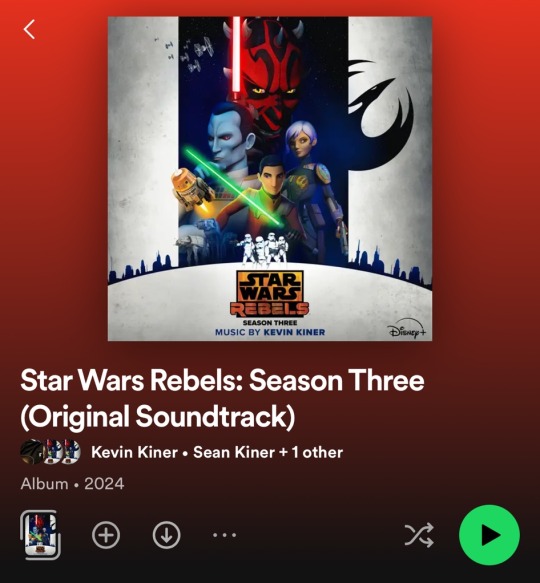
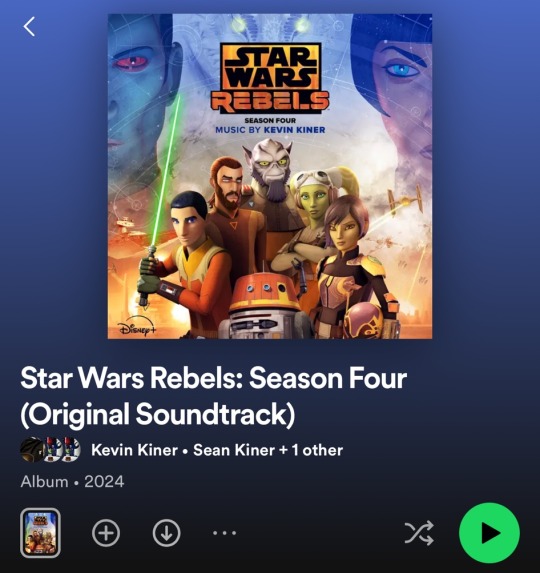
And congratulations to Sean and Deana for their official credits on the tracks!
#I have been waiting YEARS for this#official score pieces for the darksaber arc? maul vs Obi-wan? world between worlds?? Thrawn??#we’re eating well this day before May the 4th#Star Wars#Star Wars rebels#ezra bridger#kanan jarrus#sabine wren#hera syndulla#chopper#garazeb orrelios#mitth'raw'nuruodo#Thrawn#rebels#music#Spotify#star wars music
112 notes
·
View notes
Text
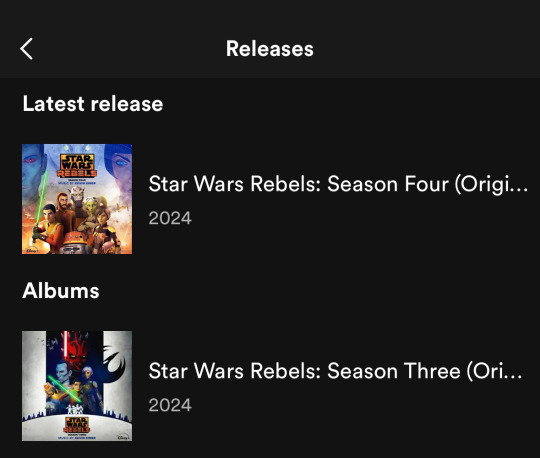
6 years late but we FINALLY got the soundtracks for Rebels seasons 3 and 4 on Spotify!!!!! everyone say thank you Kevin Kiner
#star wars#star wars soundtrack#star wars music#star wars news#kevin kiner#kiner music#star wars rebels#sw rebels#rebels
81 notes
·
View notes
Text
said it before and will say it again, Padme and Anakin’s love theme is one of the best songs in the entire series
#I love Across the Stars#but also I love Love Pledge And The Arena even more#Across the Stars is much more gentle and light than Love Pledge is#but also Love Pledge has the transition into the clone march and that part FUCKS#god the soundtrack for the whole series is just so good 😭 john williams you fucking GENIUS#star wars#star wars music#anidala
127 notes
·
View notes
Text
Ahsoka Episode 6 “Far, Far Away”: The Story, the Symbolism, and the Score
Episode 6 of Ahsoka begins with the sound of distant purrgil calls as Ahsoka and Huyang travel through hyperspace, crossing the void between galaxies. During their discussion of the tales Huyang used to tell the Jedi younglings there is no music.


I loved that Huyang said such an iconic line in this episode, reminding us that this is indeed a fairy tale, a children’s story.
The Title Card for Ahsoka appears, and then the episode title, “Far, far Away.”
We hear ominous music when Sabine is in the brig onboard the Eye of Sion. The window to her cell is shaped like an upside down triangle.
The sinister music continues during the scene with Baylan, Shin, and Morgan on the bridge. Morgan’s Theme (the Nightsister theme) is heard when the Eye of Sion exits hyperspace.
The line “Peridea is a graveyard” reminds us that this is indeed a “descent into the abyss” a stage of the hero’s journey which I have discussed on this blog before. Ominous music plays here.
The characters who are aligned with the dark side are on a quest for more power to dominate others. They have followed the Path to Peridea as a kind of path to perdition as I have mentioned in my previous metas. But Sabine, our heroine, is descending into the Underworld on a more noble quest. She hopes to find her beloved Ezra Bridger, echoing the story of Orpheus, the hero of Greek myth who descends into the Underworld to find his beloved Eurydice.
Morgan’s Theme continues when they board the shuttle and descend to the planet Peridea.
The landscape of J. R. R. Tolkien’s Middle-earth is suggested by the giant statues and the Nightsister fortress, which resembles an evil version of Minas Tirith.
The characters encounter three Nightsisters, analogous to the Three Fates of Greek mythology, the Moirai. (Note the similarities between this word and the name of Ahsoka’s owl, Morai, a creature I predict that we will be seeing again soon.)
The three Fates were the personification of destiny in Greek mythology. The three sisters were known as Clotho (the spinner), Lachesis (the alotter), and Atropos (the unturnable, a metaphor for death). The end credits for this episode name these three Nightsisters as Klothow, Lakesis, and Aktropaw, clearly indicating the intended symbolism of these three characters. As George Lucas said back in the late nineties, “Well, when I did Star Wars I consciously set about to recreate myths and the — and the classic mythological motifs. And I wanted to use those motifs to deal with issues that existed today.” (From billmoyers.com) Lucas’ apprentice, Dave Filoni, has learned this lesson from the master himself.
The music is quieter in this scene, with sounds of low vibrations being heard. Morgan’s Theme continues when Sabine is imprisoned by the Nightsisters’ three orbs, which held her bound within a triangle made of red cords of energy.
Outside of the fortress three wolf-like creatures howl as ominous music plays. Choral music suggesting the mysticism of the fallen Jedi Order is heard as Baylan speaks of Peridea being a realm of “dreams and madness” from old “children’s stories come to life.” Once again, the viewer is reminded that we are being told a fairy tale, a myth. The musical score subtly teases the listener with three notes from Ahsoka’s Ronin theme in this scene.
Sabine is imprisoned inside the Nightsister fortress as the Chimaera arrives with the sound of ominous metallic rumbling. Thrawn’s flagship Star Destroyer was named after the female fire-breathing monster in Greek mythology which was part lion, part goat, and part dragon.
I am no Freudian, but the Chimaera’s open docking bay hovering over the phallic tower of the Nightsister fortress seems to be the most overtly sexual symbolism I have seen in Star Wars in a long time. However, I’m not here to discuss that visual metaphor.

Organ music which anticipates but does not present Thrawn’s theme is heard as the Nighttroopers muster under Enoch’s command. These undead stormtroopers have cracked armor repaired with golden seams suggesting the Japanese art of kintsugi, as well as armor pieces bound with bands of red cloth. They are heard chanting “Thrawn! Thrawn!” as the Grand Admiral makes his dramatic entrance. For me this chant was reminiscent of how the orcs in Return of the King chanted “Grond! Grond!” when using their mighty battering ram against the walls of Minas Tirith. (You can do your own Freudian analysis of that scene. I’m not going there.) What was Grond?
“Grond, also known as the Wolf's Head, was a one hundred-foot long battering ram with a head in the shape of a ravening wolf, used in the arsenal of Sauron in the Third Age. Though named for Grond, Morgoth’s warhammer, it was created in the likeness of the Wolf of Angband, Carcharoth.”—from lotr.fandom.com
Creepy music accompanies the Nighttroopers as they transfer of cargo from the catacombs beneath the fortress. What is inside them? Dead Nightsisters, waiting to be revived by dark magic?
Thumps and low pitched sounds accompany Thrawn’s conversation with Baylan.
Thrawn speaks of Sabine’s desire to be reunited with her long-lost friend. (The word desire is a very intentional word choice, with the connotation that the connection between Sabine and Ezra has potential to be more than just friendship.)
Sabine: I’m sure he’s doing just fine.
Thrawn: You gambled the fate of your galaxy on that belief.
Sabine: You wouldn’t understand.
Thrawn: Perhaps not.
Evil does not understand love and loyalty. (See my previous post about the Path to Peridea.)
Enoch returns Sabine’s weapons to her, and she is provided with provisions and a wolf-like howler for a mount. He tells her to “die well” as she embarks on her “fool’s errand.”
The line about a “fool’s errand” calls to mind this scene from Tolkien’s novel, The Return of the King:
'Tell me,' he said, 'is there any hope? For Frodo, I mean; or at least mostly for Frodo.'
Gandalf put his hand on Pippin's head. 'There never was much hope,' he answered. 'Just a fool's hope, as I have been told…”
“A Fool’s Hope” was also the title of the penultimate episode of Star Wars Rebels final season.
Once again, Thrawn’s theme is only hinted at by the organ music at the end of the scene.
Sabine’s scanner is destroyed during her fight for her life with the red-armored bandits in the wastelands. Her life is saved by her Mandalorian armor and weapons, Ahsoka’s training, and Ezra’s lightsaber in this action sequence.
Baylan and Shin ride out on howlers. Nighttroopers load coffin-like cargo containers onto the Chimaera as uneasy music plays. Thrawn decides to dispatch only two squadrons of Nighttroopers. His disdain for Jedi, light or dark, is apparent: “It matters not whether Wren and Bridger are killed or stranded here. The same can be said for your two mercenaries.” Ominous music plays.
The scene with Sabine and the howler is accompanied by gentle music played upon wooden flutes. Sabine processes her abandonment issues and her complex feelings for Ezra in this scene by taking out her emotions on the howler. “You. You abandoned me. I should have known you are a coward.” She tries to make the howler stop following her, but the loyal animal comes back as soon as she walks away. “Okay. Fine,” she says. “I’ll give you another chance, but you better not bail on me this time.” The gentle flute music continues. A motif of ascending perfect fifths suggests Ezra’s Theme.
The howler stops to drink water and sniffs the air. The thing that Sabine and the audience assumes to be a rock is revealed to be a sentient little hermit-crab-like creature called a Noti. Gentle music plays when Sabine kneels, puts down her blaster, and extends her hand to the creature. The Noti recognizes the Rebel Alliance symbol (an evolution of her own Starbird design) on her pauldron. The creature has a medallion of his own, marked with a similar symbol.
“Do you know Ezra Bridger?” Sabine asks, touching her heart. “He’s my friend.”
Ominous music plays as Baylan and Shin discover the dead bandits. Once again choral music is heard when Baylan reminisces about the Jedi Order.
It is also revealed that the Nightsisters are fleeing from a power that is greater than their own.
Baylan and Shin see the red Bandits in the distance. “The enemy of our enemy is our friend,” says Baylan, “for now.”
Peaceful and noble sounding music is heard when Sabine sees the Noti encampment. She smiles at the mother Noti rocking her baby in a hammock.
With Sabine in the foreground, the camera pans to show a now adult, bearded Ezra Bridger wearing a red robe and leaning against the wall of his home. “I knew I could count on you,” he says as joyful music plays, music which features the piccolo, flute, and other woodwind instruments.
The closed captioning for this episode says that there is captivating music playing when Sabine and Ezra finally embrace. We hear a beautifully orchestrated rendition of Ezra’s Theme on the French horn with a new countermelody in the strings to heighten the emotional impact of this long-awaited scene.


Ezra’s Theme is heard again when he says “Sabine, thanks for coming. I can’t wait to go home.”
When we return to where the Chimaera is docked with the Nightsister fortress, a suggestion of Thrawn’s Theme is heard at a quick tempo suggesting the urgency of the situation that is about to unfold. Ahsoka Tano is coming. “The thread of destiny demands it” is a line that further emphasizes the three Nightsisters playing the role of the three fates. We finally hear Thrawn’s Theme presented in an obvious way as the episode ends.
I have blogged about the magnificent end credits music in previous blog posts, so this time I am going to discuss something different: the alchemical symbolism in Ahsoka.
The central focus of alchemy was to transmute base metals into gold and create the elixir of life, as any aficionado of the lore of the philosopher’s stone knows. The process is a metaphor for the purification and transformation of the human soul to a state of perfection.
Three colors symbolize this process, black, white, and red.
First there is the nigredo (blackening) stage of the alchemist’s work, representing the breaking of the human spirit. This is where both Sabine and Ahsoka are at the beginning of the series.
Second is the albedo (whitening) stage, which involves washing away impurities or vices, and being ready to grow and learn again. This is most clearly illustrated by Ahsoka the Grey’s “death” and transformation into Ahsoka the White.
Third is the rubedo (reddening) stage, which is where we are in the story right now. It represents the purified and awakened spirit reaching its highest and purest form.
“The symbols used in alchemical writing and art to represent this red stage can include blood, a phoenix , a rose, a crowned king, or a figure wearing red clothes.”—Wikipedia.
The color red, of course, is symbolic of Nightsisters and their magic in this series, as well as symbolizing the red thread of fate.
Baylan Skoll’s line about having to “destroy in order to create” is an example of the alchemical concept of “solve et coagula” meaning to separate then join together. Nothing new can be built without destroying the old. Perhaps this is really telling us about the destruction and rebuilding of the Jedi Order.
In the completion of the rubedo stage there must be a union of sulphur and mercury, also known as the wedding of the Red King (the sun) and the White Queen (the moon). Sulphur represents the masculine principle, the soul, and the fire of life. (Remember Ezra’s red robe?) Mercury represents the feminine principle and the mind, flexible and changing. (Sabine is a clever young woman who lives inside her head, sometimes too much. Lately she’s been distracted by her heart.) Mercury also represents a state that can transcend death.
Is the much-discussed Ezra and Sabine hug the union of Sulphur and Mercury? Or should we expect something more than that?
Much has been written about Baylan Skoll and Shin Hati as the mythological wolves who chase the sun and the moon. This episode ends with the pair in pursuit of Ezra (sulphur, the Red King, the sun) and Sabine (mercury, the White Queen, the moon). When Skoll and Hati catch the sun and the moon, Ragnarok begins.
Besides sulphur and mercury, there is another element present at the rubedo stage of alchemical transformation: salt.
Ahsoka the White is coming.
Please reblog and comment on what you think of my musical and literary analysis of this episode of Ahsoka. I am looking forward to reading your replies.
#sabine wren#ezra bridger#star wars#ahsoka series#sabezra#star wars rebels#ezrabine#ahsoka tano#thrawn#baylan skoll#shin hati#morgan elsbeth#nightsisters#chimaera#j r r tolkien#dave filoni#george lucas#kevin kiner#star wars music#fates#mythology#alchemy
202 notes
·
View notes
Text
I don’t think we give the ending scene and musical number of Rebels Season 2 enough love (x)
It does a perfect job wrapping up the affects of what just happened, how people are reacting to it, who is for sure alive, how they got out, Kanan turning his head towards where Ezra ans Zebs cabin is… then scene change to where Ezra is opening the sith holocron???!!! etc
And with the music which is like mournful but also hope? Or like idk. It has that finale understanding but it’s not the end vibes. (I’m bad at emotions leave me alone)
It’s so good
#Star Wars#Star Wars rebels#Star Wars music#it’s so good#orchestra music#kanan jarrus#ashoka tano#morai#ezra bridger#hera syndulla#zeb orrelios#sabine wren#captain rex
39 notes
·
View notes
Text
The March of Grand Admiral Thrawn, conducted by composer Arturo Díez Boscovich, performed live by The Malaga Philharmonic Orchestra at the MOSMA Festival in Spain in 2017. The new compositions were written and performed to accompany Timothy Zahn's classic novel, Heir to the Empire. About this new theme for Grand Admiral Thrawn, Boscovich said to the audience, "We have the march, the military march for Admiral Thrawn, who is the villain or one of the them in the book. He is related with the Empire, and because of that I tried to use that martial atmosphere to create a parallel with the Imperial March. You can also hear lyrical music within the march, because he is a real evil man, he is an alien, he has blue skin and red eyes, but he is also a true art lover. This admiral, besides being a magnificent strategist, is a charismatic person; he is elegant and he has a sensitive taste for the arts. He is a multifaceted character, and I have tried to translate all of this into the music."
#star wars#thrawn#grand admiral thrawn#arturo diez boscovich#john williams#star wars music#star wars eu#sw legends#star wars expanded universe#timothy zahn#heir to the empire#thrawn trilogy#Malaga Philharmonic Orchestra#mosma festival#star wars legends#soundtrack
78 notes
·
View notes
Text
Yeah The Phantom Menace is technically 20th century but just by a year so it gets a pass.
#star wars#leitmotif#musical score#film score#john williams#across the stars#duel of the fates#battle of the heroes#music poll#star wars movies#disney star wars#star wars music#star wars polls#film soundtrack
74 notes
·
View notes
Text
Tantiss/Hemlock theme starts playing in the background

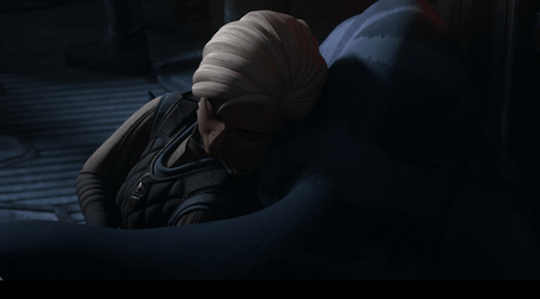
Kevin Kiner and Kiner Co. why are you doing this to us
#this is the new vadar theme#chills#kiner music absolutely SLAYING this season <3#the bad batch season 3#tbb#the bad batch#the bad batch spoilers#tbb spoilers#tbb rex#tbb hunter#tbb omega#star wars#star wars music
150 notes
·
View notes